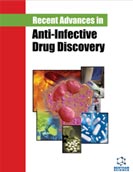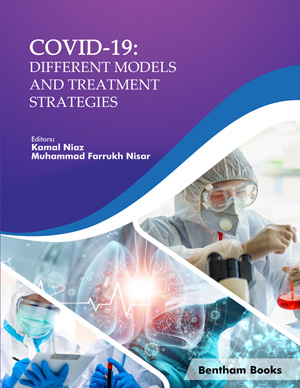Abstract
Aim: This study tries to find new antimicrobial agents using some Nigerian plants.
Background: Antimicrobial compounds from fungi endophytes have shown great promise in mitigating the threats of resistant pathogens.
Objective: The study evaluated the in vitro antimicrobial property of secondary metabolites of endophytic fungi isolated from Newbouldia laevis and Cassia tora leaves.
Methods: Ten endophytic fungi were isolated from the two plants’ leaves and later fermented on local rice for 21 days. Thereafter, their secondary metabolites were extracted using ethyl acetate. The antibacterial activity of the extracts on the test organisms were determined using agar diffusion and agar dilution methods, while the bioactive constituents were identified using high performance liquid chromatography coupled to diode array detector.
Results: Nine of the crude extracts (NL1, NL3, NL6, NL10, NL12, CT2, CT7, CT9 and CT10) of the fungi isolates inhibited at least one of the microorganisms studied with maximum and minimum inhibition-zone-diameter of 14 mm and 2 mm, respectively while CT1 did not inhibit any of the tested microorganisms at tested concentrations. The extracts exhibited good antifungal activity, inhibiting the growth of both C. albicans and Trichophyton tested with an inhibition-zone-diameter ranging between 4-8 mm and 7-14 mm, respectively. The endophytic fungi extracts-CT2 and NL1-exhibited the best antimicrobial activity, inhibiting most of the tested microorganisms. HPLC-DAD analysis of the endophytic fungal extracts identified some classes of compounds such as catechin derivatives, benzoic acid derivatives and apigenin, which were previously reported to have antimicrobial potentials.
Conclusion: Newbouldia laevis and Cassia tora leaves house endophytic fungi capable of yielding secondary metabolites with potential as anti-infective agents.
Keywords: Fungal secondary metabolites, fungal endophytes, Newbouldia laevis, Cassia tora, antimicrobial properties, Nigerian plants.
Graphical Abstract
[http://dx.doi.org/10.4236/aim.2016.67049]
[http://dx.doi.org/10.11604/pamj.2016.24.148.9270] [PMID: 27642486]
[http://dx.doi.org/10.1358/dof.2010.035.01.1452391]
[http://dx.doi.org/10.3892/br.2017.909] [PMID: 28584631]
[http://dx.doi.org/10.1021/np200906s] [PMID: 22316239]
[http://dx.doi.org/10.1128/MMBR.00050-14] [PMID: 26136581]
[http://dx.doi.org/10.13080/z-a.2015.102.060]
[http://dx.doi.org/10.1590/1678-4324-2017160542]
[http://dx.doi.org/10.3389/fmicb.2016.01538] [PMID: 27746767]
[http://dx.doi.org/10.1016/j.phytol.2015.09.004]
[http://dx.doi.org/10.3109/08923973.2013.834930] [PMID: 24041314]
[http://dx.doi.org/10.3390/antibiotics8040156] [PMID: 31547023]
[http://dx.doi.org/10.26538/tjnpr/v2i7.6]
[http://dx.doi.org/10.3390/microorganisms7070197] [PMID: 31295889]
[PMID: 24363738]
[http://dx.doi.org/10.1155/2018/9105261] [PMID: 30105263]
[http://dx.doi.org/10.1016/j.fct.2013.04.025] [PMID: 23607932]
[http://dx.doi.org/10.5681/apb.2012.015] [PMID: 24312778]
[http://dx.doi.org/10.2478/s11756-007-0044-1]
[http://dx.doi.org/10.1002/mnfr.200700428] [PMID: 19065580]
[http://dx.doi.org/10.1155/2013/162750] [PMID: 24470791]
[http://dx.doi.org/10.1007/s10482-015-0492-5] [PMID: 26036671]
[http://dx.doi.org/10.3390/molecules22081349] [PMID: 28805750]
[http://dx.doi.org/10.1248/bpb.27.277] [PMID: 14993788]
[http://dx.doi.org/10.5021/ad.2014.26.5.564] [PMID: 25324647]
[http://dx.doi.org/10.1007/s10156-003-0284-0] [PMID: 14991521]
[http://dx.doi.org/10.1111/bph.12009] [PMID: 23072320]
[http://dx.doi.org/10.3389/fmicb.2012.00053] [PMID: 22355295]
[http://dx.doi.org/10.3389/fmicb.2019.00911] [PMID: 31156565]
[http://dx.doi.org/10.3390/molecules191016240] [PMID: 25310150]
[http://dx.doi.org/10.1155/2013/308980] [PMID: 23878595]
[http://dx.doi.org/10.1016/S0378-8741(97)00128-1] [PMID: 9533435]
[http://dx.doi.org/10.1016/j.fitote.2015.06.018] [PMID: 26136060]
[http://dx.doi.org/10.1002/slct.201600478]
[http://dx.doi.org/10.1134/S107036321204010X]
[http://dx.doi.org/10.1089/fpd.2008.0187] [PMID: 19099360]
























